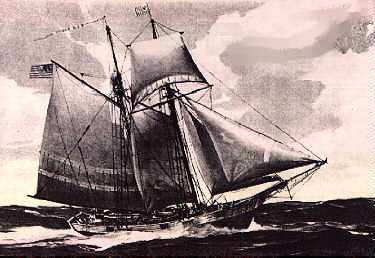
United States Coast Guard ____________________________________

When you hear the word "cutter" you think
right away of the United States Coast Guard. In the mind of everyone, cutter
means only one thing-a Coast Guard ship. Once, though, cutter was a term that
meant a particular type vessel-a schooner with heavy keel that permitted it
to carry plenty of sail aloft for speed.
Such were the 10 ships that Congress
authorized Alexander Hamilton, first Secretary of the
Treasury and father of the Coast Guard, to build in 1790 to stamp out smuggling
along the
coast of the new Union of 13 States. The first of these cutters, launched in
1791, was the
Massachusetts. Her deck length was only 5 feet, her beam 17 1/2; her draft 7
feet 3 inches,
her armament 6 light swivel guns. Her 9 sister cutters were still smaller, ranging
downward
to 30 tons. Yet for 8 years, until the regular Navy was organized in 1798, these
tiny wooden
sailing ship were the young Nation’s sole naval force.
Today, after more than a century and
a half, the Revenue Marine, as it was first called, has
grown into the powerful, far-flung establishment of ships, planes, and stations
that we know
as the Coast Guard. It still keeps smugglers in check, but to that original
assignment have
been added innumerable other duties, which for convenience may be grouped
into three general categories:
First, the Coast Guard is a safety agency.
Charged with the protection of life and property
at sea it maintains ships to report on midocean weather conditions; ice patrols
to warn of
dangerous bergs; and loran stations, lighthouses, and buoys to guide mariners
safely to land.
And when accidents occur despite all safety precautions, there are lifeboat
stations to cope
with emergencies along the shore and Coast Guard planes, heli-copters, and cutters
for
long-range assistance operations. When necessary, the Coast Guard requests merchant
vessels to assist in rescue work.
Second, the Coast Guard is an enforcement
agency. As such! its task is to see that Federal
laws are observed on the high sea and navigable waters of the United States.
This means all
Federal laws, but violations of statutes governing immigration and customs,
operation of
merchant ships and motorboats, oil pollution of waterways, and the like, are
a particular
concern of the Coast Guard.
Third, the Coast Guard is a part of the
Nation's Armed Forces. Transferred in wartime or on
direction by the President from the Treasury to the Navy, the Coast Guard has
fought with
distinction in every war in which the United States has been involved. In World
War II, it
reached peak manpower of 171,000 and distinguished itself in all theaters of
war,
particularly in amphibious assaults, antisubmarine warfare, and port security
work.
This info came from U.S. Government Printing Office: 1955-O-334853